Orchestra Spotlight: Central Ohio Symphony
 The Central Ohio Symphony is a small budget orchestra located in Delaware county, Ohio. The City has a population of 38,000, the county about 185,000. Delaware, 23 miles from Columbus, is home to Ohio Wesleyan University and is very much a college town. Indeed, the Symphony was originally affiliated with the University, and became an independent organization in 1978. Delaware county is one of the top 20 fastest-growing and wealthiest counties in the country, though there are large pockets of rural populations who are economically depressed.
The Central Ohio Symphony is a small budget orchestra located in Delaware county, Ohio. The City has a population of 38,000, the county about 185,000. Delaware, 23 miles from Columbus, is home to Ohio Wesleyan University and is very much a college town. Indeed, the Symphony was originally affiliated with the University, and became an independent organization in 1978. Delaware county is one of the top 20 fastest-growing and wealthiest counties in the country, though there are large pockets of rural populations who are economically depressed.
According to Warren Hyer, Executive Director and Symphony Timpanist, the town is quite a dichotomy – it’s not a homogenous community. There’s not a lot of diversity in terms of ethnicity but it’s quite diverse in terms of education, income, and employment structure. It’s not heavily industrial and has started to be considered a Columbus suburb by some. However, it’s a vibrant community with a strong downtown and very much the feel of a college town.
The Central Ohio Symphony presents a four-concert subscription series, including a Holiday concert, a huge 4th of July outdoor concert (with about 8,000 in attendance), one or two runouts a year, and a smattering of other performances. They have a budget ranging from $200,000 to $220,000, and all musicians are now paid employees. Warren Hyer is the only full-time employee; he has a part-time assistant.
Their mission statement is quite succinct: “Engaging the community through music.”
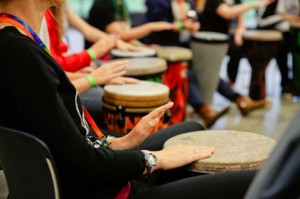
Drum Circle
Why has Polyphonic chosen to spotlight such a small orchestra? Because they are the recipients of three Getty Foundation Grants for their Reconnecting program in the juvenile justice system in Delaware county. Indeed, they are the only orchestra of their size to receive such a grant – decided through a merit system run by the League of American Orchestras. And they are the only orchestra in the country involved in a Mental Health Court program.
Warren and Caitie Thompson, a percussionist in the symphony, conduct therapeutic drumming circles within the Juvenile Treatment Court. They work with high-school aged youth who are in the court system because of a substance abuse or mental health problem. They also work with an adult mental health court/docket – adults who are court-involved because they have a mental illness with a co-occurring drug problem (drug or alcohol). And they are about to begin work with an adult-dependency court, which is administered by juvenile treatment – this population involves adults whose drug abuse problem is so critical that their children have been taken away.
Ohio is a leader in the court docket system. The Treatment Court of the Delaware County Juvenile Court is a special docket for juvenile offenders with mental illnesses and/or substance use disorders. The Treatment Court uses a post-sentencing program to help juvenile offenders gain control over their illness or disorder, to take responsibility for both their offense and their personal development, and to reconnect as healthier individuals with their families and community. The Treatment Court was established in 2000 to break the cycle of repeated criminal activity among such youth.
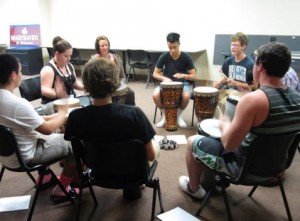
Drumming with Court Youth
The youthful offenders enter into a 1-2 year program in which they meet with a doctor, a therapist, a probation officer, and program coordinators assigned to this program. They also meet with the judge on a weekly basis. The Treatment Court program is a mentoring program, which helps the youth get off drugs or alcohol, find the mental health services they need, and find a place to live. The program helps them make these transitions so they can find a job, rebond with their families and become self-sufficient. As their behavior changes and they display positive actions, their court appearances become bi-weekly, and finally monthly.
According to Warren, “It’s remarkable what you see people able to accomplish. They come in on the edge of homelessness, having had difficulty in finding jobs – they are ’frequent flyers’ in the court system. Our goal is that they become self-sufficient, are able to hold a job, take care of themselves, and function reasonably well on a day-by-day basis.”
Caitie, Warren and therapist Rhonda Milner from Maryhaven, a local treatment provider with whom the Symphony has partnered, attended training sessions at REMO in California in therapeutic drumming protocols – a process called HealthRHYTHMS. These protocols mirror the court’s treatment process, and support the same goals as the court. The court was trying to find activities to engage the youth in the court program, and Warren approached the court with a short video about therapeutic drumming. The court was very excited because the Symphony would be involved and because Warren is well known in the community, and thus was born Reconnecting.
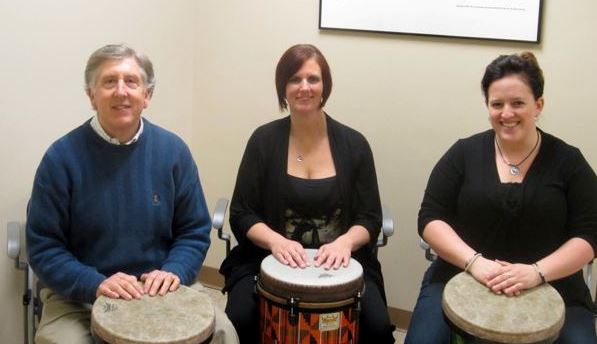
Warren Hyer, Rhonda Milner, & Caitie Thompson
Caitie Thompson described in detail the process of working with the court-involved youth.
“We start with a wellness exercise, such as breathing, which gets them grounded and centered. We always use a series of steps, as this is a group of people who have never met each other before and who most likely have no musical background at all. We take them through an icebreaker to release tension in the group circle, as many of them are tense and anxious. One of the best is the Shaker Pass – we use lemon shakers and have the participants pass them around and do various permutations of how to pass them. It’s a silly exercise but it gets people laughing.
Then we introduce the drums. There are many different ways to play a drum; we often use somebody’s name to start creating a rhythm. For example, I’ll hit the drum three times and say “Caitie Thompson,” or I rub my hand across the drum head to create a soothing sound. We want to get them familiar with touching and manipulating the drums.
The next step is entrainment, where a group of people start playing together, and then a rhythm forms. They play together and then play off of each other. Typically it takes about 20 minutes to get to this point, with the group starting to groove. We may then add in the use of shakers and tambourines for different colors.
We also do ‘Inspirational Beats,’ where we pose a question to the group, such as “How are you feeling today?” The catch is that they’re not allowed to respond with words but instead must play their emotion on the drum. For example, one youth might play super hard and very fast. Before they tell us what they’re feeling, we have other members guess – “It sounded like anger” or “He’s anxious” or “He’s excited.” We use drums to help them channel feelings.
An example learned at the training involved a group of autistic kids who were asked how it feels to be bullied. One participant, who has trouble with verbal skills, suddenly sat forward and hit his drum while he said, “It makes me mad!” This was the clearest and most descriptive he’d ever been verbally. He was able to speak his mind by using the drum. Drumming can help a participant effectively communicate in non-verbal ways.”
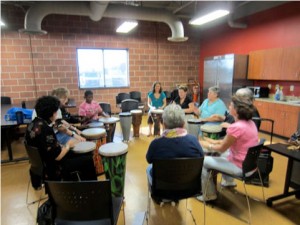
Cancer Support Drum Circle
A major component of the therapeutic drumming protocol is that the facilitators shouldn’t lead the group, but rather the group should lead itself. Caitie described a session with participants who had been in the program for a while:
“The kids at Maryhaven don’t like authority; they want to feel in control. In our drum circles, we give them the opportunity to lead, to start the conversation for the day. During the last session I did in the spring, the guys were starting to talk about trying to stay clean long enough to get off probation when they’re 18 and their record gets wiped clean. Another participant was listening, then said, “Why would you go through all this therapy, go through all this work, only to come back and screw it up again when you turn 18? Why couldn’t you just stay sober?” I could see the group dynamic totally change as they began to discuss this.”
Warren describes the benefits of drumming thusly:
“Court-involved youth, especially those with substance use disorders and/or mental illness, often do not have many successes in their lives. Drumming circles can give them a successful experience.
According to the literature on drumming circles affecting social-emotional behavior, drumming is a transformative activity, and drumming circles are a vehicle for expression and creativity through which participants gain self-confidence, personal development, and positive peer support. Drumming builds skills in cooperation, develops learning capabilities, and enhances leadership skills.”
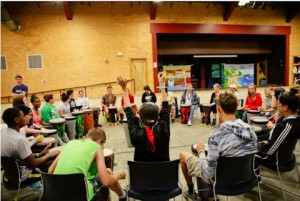
Flying Horse Farms Drum Circle
Warren and Caitie have been in the courtroom on occasion, but they do most of their work at Maryhaven, a treatment facility specializing in treating people with addictive and mental illness, which is just a few hundred feet from the courthouse. They sit in court team meetings, which occur once a month, help make evaluations of the progress of the youth, share the progress of the participants, and describe what the symphony musicians see that’s different from what the court officials see. They also go to the court graduations. In addition, Warren serves on the Mental Health Advisory Committee with other public officials
In addition to the court-involved youth, Warren and Caitie also work with adult populations at Maryhaven. Caitie describes these drum circles as “more light-hearted; we do more recreational drumming because they need to break up the heavy therapy. Rhonda {Milner, Maryhaven therapist] adds inspirational beats around the theme that they’ll be talking about in group session Some adults bring their own drums – it helps them release their emotions if they’re having a bad day, and they can play at home.”
A very special event occurred in April, 2015, when the Central Ohio Symphony premiered Reconnecting, a piece by Ben Goldberg, written for orchestra and drum circle. Several participants from the adolescent and adult program played, as well as clinicians and magistrate Lynn Schoenling. The performance is available on YouTube.
Composer Ben Goldberg describes the piece thusly:
Composer Ben Goldberg, Warren Hyer, and Caitie Thompson
“RECONNECTING is a programmatic composition that tells the story of participants in a unique rehabilitation program for juvenile and adult offenders with mental illness or substance abuse issues. The Treatment Court of the Delaware County Juvenile Court, Delaware County Municipal Mental Health Docket, and Maryhaven Treatment Center are designed to help participants gain control over their illness or addiction, to take responsibility for both their offense and their personal development, and to reconnect as healthier individuals to their families and community. The Central Ohio Symphony’s Reconnecting program developed the groundbreaking therapeutic drum circles for all three of these programs. I traveled several times to Delaware to conduct research for the composition. I attended juvenile and adult court hearings and met with the program’s support team comprised of the Magistrate, Probation Officer, Therapist, and Treatment Services Department Head. This allowed me to gain valuable knowledge of the program and see firsthand the efforts taking place to help rehabilitate the offenders. I also attended a drum circle session and was able to speak directly with the participants about their experiences in the program, as well as witness the type of drumming techniques they were learning. From these discussions and observations I created the structure for RECONNECTING, which is built on the progression of the participants though the court program: their initial Offense, three rehabilitation phases, Graduation, and the Future.
Rehearsal for Ben Goldberg’s Reconnecting
The three rehabilitation phases possess common symbolic elements that create cohesion within the piece. The “Call and Response” sections represent the progress of the participants through the program and their relationship with the court and wider community. In phase one there is a “Call” from the orchestra but no response from the drummers. In phase two the orchestra’s “Call” is met with a mutual “Response.” In phase three the “Call” is initiated by the drummers and the “Response” is from the orchestra. The support team theme likewise becomes more positive and nurturing with every iteration. A gavel strike, in the percussion section, represents the frequency of the court hearings in each stage of the program, and is heard less regularly as the participants are granted more independence. Each phase also contains a “Story” which is directly inspired from my observations while conducting research for the composition. In addition to “Call and Response,” other drumming techniques common to drum circle sessions that appear in the score include “Heartbeat,” “Shaker Pass,” and “Speaking” of names. The “Heartbeat” goes through several emotional transformations throughout the piece ranging from terrified to proud. The “Shaker Pass” is used in the Promotion sections to symbolize the passage of time. During the Graduation portion of the piece, the drummers announce themselves individually by improvising a musical interpretation of “Speaking” their names with the drums. This gives them an opportunity to express how they would like to be perceived on graduation day.”
Slowly the court-involved individuals began to realize what a “big deal” it was to be performing with the Central Ohio Symphony. According to Caitie, “In rehearsal with just the drums, an adolescent was walking around the stage, taking it all in, taking pictures on his phone. He mused, “This is like people play here – this is a big deal, isn’t it?” We explained that famous people in classical music have been on this stage – and it started to sink in that it was a phenomenal experience. In rehearsal, they were looking at the conductor and asking, “What is he doing?” They kept looking at me to lead them, but eventually they realized that ‘that guy’ [conductor Jaime Morales-Matos] was on fire, that he’s passionate about this, as were the other orchestra musicians.
As rehearsal came to an end, the orchestra members were applauding the drum circle, patting them on the back, shaking their hands, saying, “We’re glad you’re here, we can’t wait to do the concert with you.” The look on the kids’ faces was priceless – such a sense of accomplishment. They were proud of what they’re doing. It’s not necessarily easy, as it took weeks of practice – these are kids that have never paid much attention to playing an instrument. I walked out of the auditorium feeling so proud of their accomplishment.”
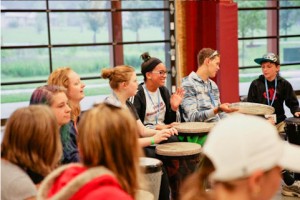
Flying Horse Farms Drum Circle
Warren and Caitie are expanding their drum circles. They recently received a grant to do some work at Flying Horse Farms, a respite camp for children with serious illnesses such as cancer. They spent six weeks over the summer working with these kids once a week. The Ohio School Board Association has contacted Warren about starting a drum circle, and they’ve begun working with the local Big Brother/Big Sister organization. Caitie describes all of this as a “life-changing experience for me. I’m in utter awe of what we’re doing with drums and music, to help improve the quality of life of the participants.”
Both Warren and Caitie talked about the concept of success with the court-involved youth population.
Warren: “What we tend to do is look at progress, not success. Not everyone is successful because they choose not to be or success is not what they want. And juveniles sometimes have no control over their lives.”
Caitie: “We measure success in small increments. Just getting them to come to the [drum] circle – making sure they show up for therapy – is a success. The day they’re no longer on ankle monitors is a success. We need to take baby steps to help acclimate these kids to get back into society.”
Polyphonic salutes Warren, Caitie, and the Central Ohio Symphony for their wonderful work in their community, making significant change in the lives of so many individuals.
– Ann Drinan, September, 2015

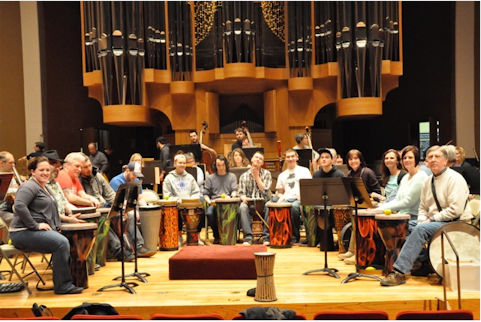
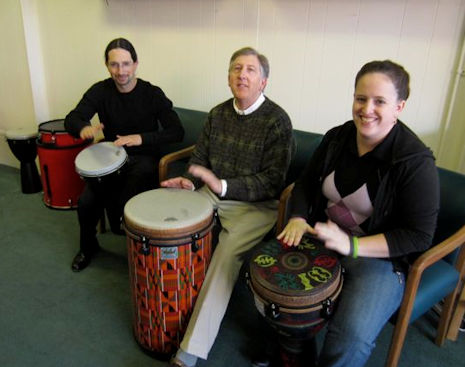
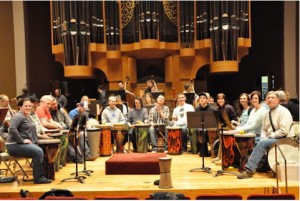
My life has been forever changed by being able to be a part of a drum circle.
Thank you for taking on all of these great projects.